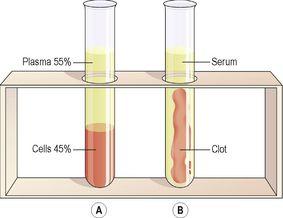Ross & Wilson Anatomy and Physiology in Health and Illness (27 page)
Read Ross & Wilson Anatomy and Physiology in Health and Illness Online
Authors: Anne Waugh,Allison Grant
Tags: #Medical, #Nursing, #General, #Anatomy

•
clotting factors that coagulate blood, minimising bleeding from ruptured blood vessels.
Blood is composed of a clear, straw-coloured, watery fluid called
plasma
in which several different types of blood cell are suspended. Plasma normally constitutes 55% of the volume of blood. The remaining 45% is accounted for by the cellular fraction of blood. The two fractions of blood, blood cells and plasma, can be separated by centrifugation (spinning) or by gravity when blood is allowed to stand (
Fig. 4.1A
). Because the cells are heavier than plasma, they sink to the bottom of any sample.
Figure 4.1
A.
The proportions of blood cells and plasma in whole blood separated by gravity.
B.
A blood clot in serum.
Blood makes up about 7% of body weight (about 5.6 litres in a 70 kg man). This proportion is less in women and considerably greater in children, gradually decreasing until the adult level is reached.
Blood in the blood vessels is always in motion because of the pumping action of the heart. The continual flow maintains a fairly constant environment for body cells. Blood volume and the concentration of its many constituents are kept within narrow limits by homeostatic mechanisms.
The first part of the chapter describes normal blood physiology, and the later sections are concerned with some disorders of the blood.
Plasma
Learning outcomes
After studying this section, you should be able to:
list the constituents of plasma
describe their functions.
The constituents of plasma are water (90 to 92%) and dissolved and suspended substances, including:
•
plasma proteins
•
inorganic salts
•
nutrients, principally from digested foods
•
waste materials
•
hormones
•
gases.
Plasma proteins
Plasma proteins, which make up about 7% of plasma, are normally retained within the blood, because they are too big to escape through the capillary pores into the tissues. They are largely responsible for creating the osmotic pressure of blood (
p. 78
), which keeps plasma fluid within the circulation. If plasma protein levels fall, because of either reduced production or loss from the blood vessels, osmotic pressure is also reduced, and fluid moves into the tissues (oedema) and body cavities.
Plasma viscosity (thickness) is due to plasma proteins, mainly albumin and fibrinogen. Plasma proteins, with the exception of immunoglobulins, are formed in the liver.
Albumins
These are the most abundant plasma proteins (about 60% of total) and their main function is to maintain normal plasma osmotic pressure. Albumins also act as carrier molecules for free fatty acids, some drugs and steroid hormones.
Globulins
Their main functions are:
•
as
antibodies
(immunoglobulins), which are complex proteins produced by lymphocytes that play an important part in immunity. They bind to, and neutralise, foreign materials (antigens) such as micro-organisms (see also
p. 371
).
•
transportation of some hormones and mineral salts, e.g. thyroglobulin carries the hormone thyroxine and transferrin carries the mineral iron
•
inhibition of some proteolytic enzymes, e.g. α
2
macroglobulin inhibits trypsin activity.
Clotting factors
These are responsible for coagulation of blood (
p. 64
).
Serum
is plasma from which clotting factors have been removed (
Fig. 4.1B
). The most abundant clotting factor is
fibrinogen.
Electrolytes
These have a range of functions, including muscle contraction (e.g. Ca
2+
), transmission of nerve impulses (e.g. Ca
2+
and Na
+
), and maintenance of acid–base balance (e.g. phosphate, ). The pH of blood is maintained between 7.35 and 7.45 (slightly alkaline) by an ongoing complicated series of chemical activities, involving buffering systems.
). The pH of blood is maintained between 7.35 and 7.45 (slightly alkaline) by an ongoing complicated series of chemical activities, involving buffering systems.
Nutrients
The products of digestion, e.g. glucose, amino acids, fatty acids and glycerol, are absorbed from the alimentary tract. Together with mineral salts and vitamins they are used by body cells for energy, heat, repair and replacement, and for the synthesis of other blood components and body secretions.
Waste products
Urea, creatinine and uric acid are the waste products of protein metabolism. They are formed in the liver and carried in blood to the kidneys for excretion.
Hormones (see
Ch. 9
)
These are chemical messengers synthesised by endocrine glands. Hormones pass directly from the endocrine cells into the blood, which transports them to their target tissues and organs elsewhere in the body, where they influence cellular activity.
Gases
Oxygen, carbon dioxide and nitrogen are transported round the body dissolved in plasma. Oxygen and carbon dioxide are also transported in combination with haemoglobin in red blood cells (
p. 58
). Most oxygen is carried in combination with haemoglobin and most carbon dioxide as bicarbonate ions dissolved in plasma (
p. 252
). Atmospheric nitrogen enters the body in the same way as other gases and is present in plasma but it has no physiological function.
Cellular content of blood
Learning outcomes
After studying this section, you should be able to:
discuss the structure, function and formation of red blood cells, including the systems used in medicine to classify the different types


